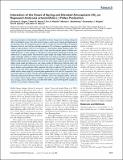| dc.contributor.author | Rogers, Christine Anne | |
| dc.contributor.author | Wayne, Peter Michael | |
| dc.contributor.author | Macklin, Eric Allen | |
| dc.contributor.author | Muilenberg, Michael L. | |
| dc.contributor.author | Wagner, Christopher J. | |
| dc.contributor.author | Epstein, Paul Robert | |
| dc.contributor.author | Bazzaz, Fakhri A. | |
| dc.date.accessioned | 2011-04-22T18:35:13Z | |
| dc.date.issued | 2006 | |
| dc.identifier.citation | Rogers, Christine A., Peter M. Wayne, Eric A. Macklin, Michael L. Muilenberg, Christopher J. Wagner, Paul R. Epstein, and Fakhri A. Bazzaz. 2006. Interaction of the Onset of Spring and Elevated Atmospheric CO2 on Ragweed (Ambrosia artemisiifolia L.) Pollen Production. Environmental Health Perspectives 114(6): 865-869. | en_US |
| dc.identifier.issn | 0091-6765 | en_US |
| dc.identifier.uri | http://nrs.harvard.edu/urn-3:HUL.InstRepos:4874387 | |
| dc.description.abstract | Increasing atmospheric carbon dioxide is responsible for climate changes that are having widespread effects on biological systems. One of the clearest changes is earlier onset of spring and lengthening of the growing season. We designed the present study to examine the interactive effects of timing of dormancy release of seeds with low and high atmospheric CO2 on biomass, reproduction, and phenology in ragweed plants (Ambrosia artemisiifolia L.), which produce highly allergenic pollen. We released ragweed seeds from dormancy at three 15-day intervals and grew plants in climate-controlled glasshouses at either ambient or 700-ppm CO2 concentrations, placing open-top bags over inflorescences to capture pollen. Measurements of plant height and weight; inflorescence number, weight, and length; and days to anthesis and anthesis date were made on each plant, and whole-plant pollen productivity was estimated from an allometric-based model. Timing and CO2 interacted to influence pollen production. At ambient CO2 levels, the earlier cohort acquired a greater biomass, a higher average weight per inflorescence, and a larger number of inflorescences; flowered earlier; and had 54.8% greater pollen production than did the latest cohort. At high CO2 levels, plants showed greater biomass and reproductive effort compared with those in ambient CO2 but only for later cohorts. In the early cohort, pollen production was similar under ambient and high CO2, but in the middle and late cohorts, high CO2 increased pollen production by 32% and 55%, respectively, compared with ambient CO2 levels. Overall, ragweed pollen production can be expected to increase significantly under predicted future climate conditions. | en_US |
| dc.language.iso | en_US | en_US |
| dc.publisher | National Institute of Environmental Health Sciences | en_US |
| dc.relation.isversionof | doi:10.1289/ehp.8549 | en_US |
| dc.relation.hasversion | http://www.ncbi.nlm.nih.gov/pmc/articles/PMC1480488/pdf/ | en_US |
| dash.license | LAA | |
| dc.subject | allergenic pollen | en_US |
| dc.subject | Ambrosia artemisiifolia | en_US |
| dc.subject | climate change | en_US |
| dc.subject | climate variability | en_US |
| dc.subject | elevated CO2 | en_US |
| dc.subject | global warming | en_US |
| dc.subject | ragweed | en_US |
| dc.subject | springtime warming | en_US |
| dc.title | Interaction of the Onset of Spring and Elevated Atmospheric CO2 on Ragweed (Ambrosia artemisiifolia L.) Pollen Production | en_US |
| dc.type | Journal Article | en_US |
| dc.description.version | Version of Record | en_US |
| dc.relation.journal | Environmental Health Perspectives | en_US |
| dash.depositing.author | Rogers, Christine Anne | |
| dc.date.available | 2011-04-22T18:35:13Z | |
| dash.affiliation.other | SPH^Exposure Epidemiology and Risk Program | en_US |
| dash.affiliation.other | SPH^Exposure Epidemiology and Risk Program | en_US |
| dash.affiliation.other | HMS^Global Health and Social Medicine | en_US |
| dash.affiliation.other | HMS^Center for Health and the Global Environment | en_US |
| dc.identifier.doi | 10.1289/ehp.8549 | * |
| dash.contributor.affiliated | Muilenberg, Michael | |
| dash.contributor.affiliated | Wayne, Peter | |
| dash.contributor.affiliated | Rogers, Christine Anne | |
| dash.contributor.affiliated | Epstein, Paul | |
| dash.contributor.affiliated | Macklin, Eric | |


